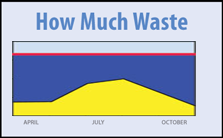Lake Mead at Lowest Level Since 1950
Water levels in Lake Mead, the largest reservoir in the United States, stand at the lowest level in more than 50 years, according to published reports.
In August, the water elevation in Lake Mead stood at 1,087 feet above sea level. If the water level drops just 12 feet to 1,075 feet, a temporary distribution plan approved in 2007 by the seven states with claims to the river and by the federal Bureau of Reclamation will be invoked.
Under this distribution plan, water deliveries to Arizona and Nevada would be reduced. This could trigger significant curtailment efforts across the Southwest. California, which has first call on the Colorado River flows in the lower basin, would not be affected.
To avoid this situation, reservoir operators could release more water from Lake Powell in Utah, which is currently holding approximately 50 per cent more water than Lake Mead.
Terry Fulp, deputy regional director of the Bureau of Reclamation for the Lower Colorado Region says this is the first time ever that the bureau has judged a critical shortage to be remotely possible in the near future.
"We're approaching the magical line that would trigger shortage," Fulp told the New York Times. "We have the lowest 11-year average in the 100-year-plus record history of flows in the basin." Lake Mead was created by the damming of the Colorado River, a project completed in 1936. Lake Mead is named after Elwood Mead, the Bureau of Reclamation commissioner at the time.


